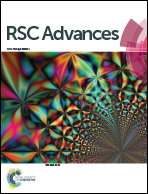Nanosized spinel Cu–Mn mixed oxide catalyst prepared via solvent evaporation for liquid phase oxidation of vanillyl alcohol using air and H2O2
Abstract
A highly crystalline and spinel-structured Cu–Mn mixed oxide prepared via a solvent evaporation technique demonstrated superior catalytic activity for the oxidation of vanillyl alcohol to vanillin using different oxygen sources, air and H2O2, under optimum reaction conditions. The Cu–Mn mixed oxide catalyst contains large concentrations of structural defects (i.e. surface oxygen vacancy sites, defective oxygen species and grain boundaries) which act as active sites to enrich the transformation of vanillyl alcohol to vanillin. The atomic ratio of Cu and Mn in the metal oxides was observed to influence the catalytic performance significantly under similar reaction conditions. Moreover, reaction conditions such as time, solvent, temperature, and pressure were investigated to achieve suitable reaction parameters for the oxidation of vanillyl alcohol. For the catalytic activity, 94% conversion was measured with 99% selectivity for vanillin using H2O2 in the presence of base. Meanwhile, 91% conversion with 81% selectivity for vanillin was obtained by liquid phase aerobic oxidation in base-free conditions. The catalyst also showed high stability for three recycling redox reactions.


 Please wait while we load your content...
Please wait while we load your content...